2017 Peugeot 308 brake
[x] Cancel search: brakePage 206 of 566
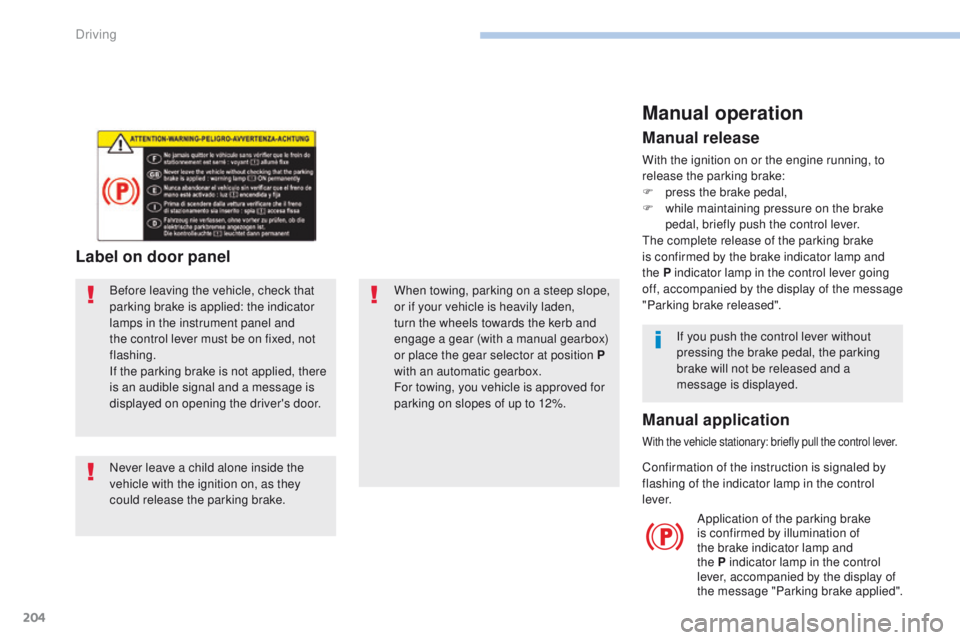
204
3008-2_en_Chap06_conduite_ed01-2016
When towing, parking on a steep slope,
or if your vehicle is heavily laden,
turn the wheels towards the kerb and
engage a gear (with a manual gearbox)
or place the gear selector at position P
with an automatic gearbox.
For towing, you vehicle is approved for
parking on slopes of up to 12%.
Manual operation
Manual application
With the vehicle stationary: briefly pull the control lever.
If you push the control lever without
pressing the brake pedal, the parking
brake will not be released and a
message is displayed.
Manual release
With the ignition on or the engine running, to
release the parking brake:
F
p
ress the brake pedal,
F
w
hile maintaining pressure on the brake
pedal, briefly push the control lever.
The complete release of the parking brake
is confirmed by the brake indicator lamp and
the
P indicator lamp in the control lever going
off, accompanied by the display of the message
"Parking brake released".
Never leave a child alone inside the
vehicle with the ignition on, as they
could release the parking brake. Before leaving the vehicle, check that
parking brake is applied: the indicator
lamps in the instrument panel and
the control lever must be on fixed, not
flashing.
If the parking brake is not applied, there
is an audible signal and a message is
displayed on opening the driver's door.
Label on door panel
Confirmation of the instruction is signaled by
flashing of the indicator lamp in the control
l eve r. Application of the parking brake
is confirmed by illumination of
the brake indicator lamp and
the
P indicator lamp in the control
lever, accompanied by the display of
the message "Parking brake applied".
Driving
Page 207 of 566
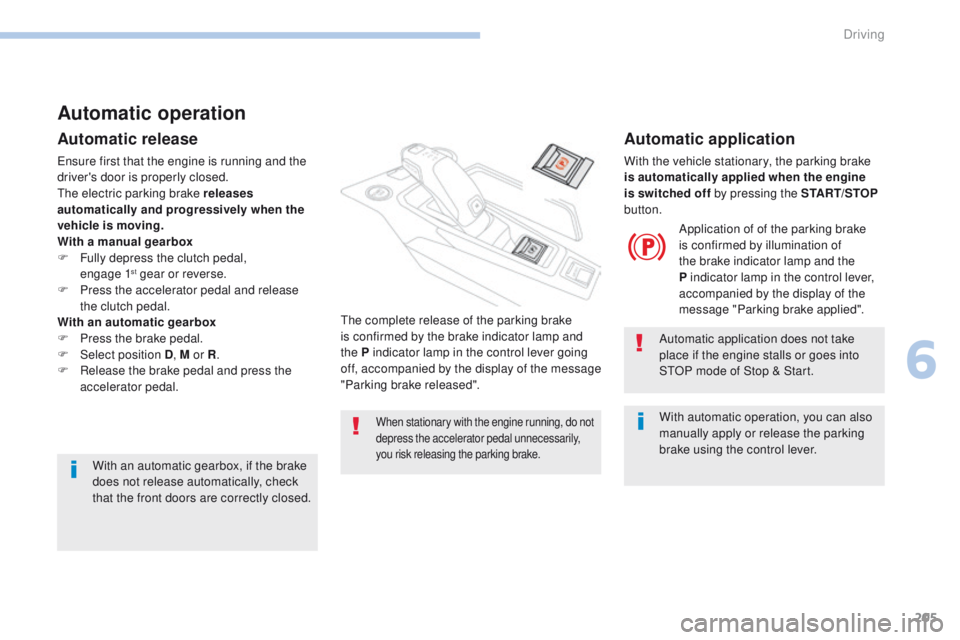
205
3008-2_en_Chap06_conduite_ed01-2016
Automatic operation
Automatic release
Ensure first that the engine is running and the
driver's door is properly closed.
The electric parking brake releases
automatically and progressively when the
vehicle is moving.
With a manual gearbox
F
F
ully depress the clutch pedal,
engage 1
st gear or reverse.
F
P
ress the accelerator pedal and release
the clutch pedal.
With an automatic gearbox
F
P
ress the brake pedal.
F
Sel
ect position D , M or R.
F
R
elease the brake pedal and press the
accelerator pedal.
With an automatic gearbox, if the brake
does not release automatically, check
that the front doors are correctly closed.
When stationary with the engine running, do not
depress the accelerator pedal unnecessarily,
you risk releasing the parking brake.
The complete release of the parking brake
is confirmed by the brake indicator lamp and
the P indicator lamp in the control lever going
off, accompanied by the display of the message
"Parking brake released".
Automatic application
With the vehicle stationary, the parking brake
is automatically applied when the engine
is switched off by pressing the START/STOP
button.
Application of of the parking brake
is confirmed by illumination of
the brake indicator lamp and the
P
indicator lamp in the control lever,
accompanied by the display of the
message "Parking brake applied".
Automatic application does not take
place if the engine stalls or goes into
STOP mode of Stop & Start.
With automatic operation, you can also
manually apply or release the parking
brake using the control lever.
6
Driving
Page 208 of 566
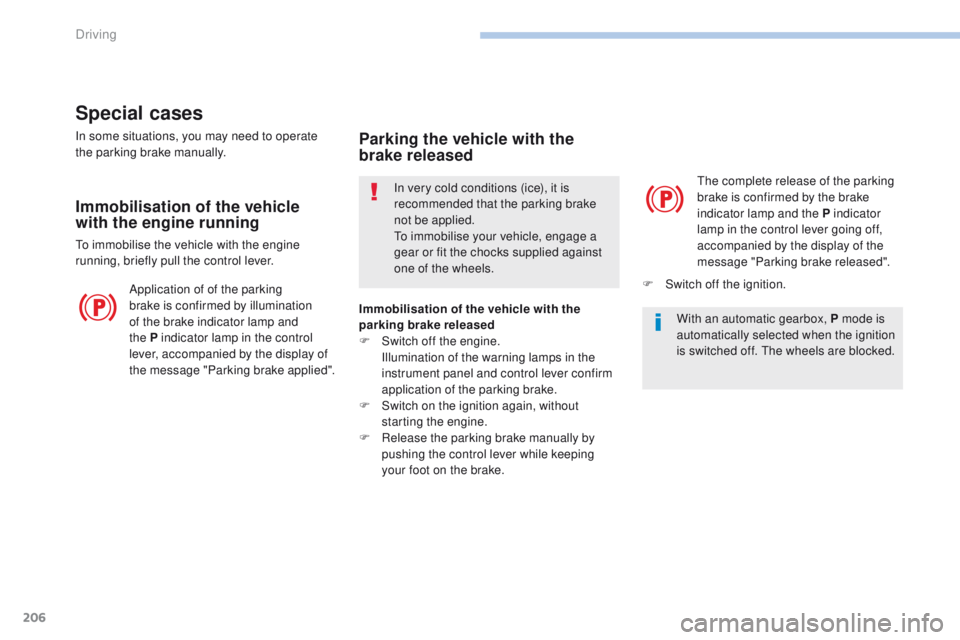
206
3008-2_en_Chap06_conduite_ed01-2016
Special cases
In some situations, you may need to operate
the parking brake manually.
Immobilisation of the vehicle
with the engine running
To immobilise the vehicle with the engine
running, briefly pull the control lever.In very cold conditions (ice), it is
recommended that the parking brake
not be applied.
To immobilise your vehicle, engage a
gear or fit the chocks supplied against
one of the wheels.
Application of of the parking
brake is confirmed by illumination
of the brake indicator lamp and
the
P indicator lamp in the control
lever, accompanied by the display of
the message "Parking brake applied".
Parking the vehicle with the
brake released
Immobilisation of the vehicle with the
parking brake released
F
S
witch off the engine.
I
llumination of the warning lamps in the
instrument panel and control lever confirm
application of the parking brake.
F
S
witch on the ignition again, without
starting the engine.
F
R
elease the parking brake manually by
pushing the control lever while keeping
your foot on the brake. The complete release of the parking
brake is confirmed by the brake
indicator lamp and the P indicator
lamp in the control lever going off,
accompanied by the display of the
message "Parking brake released".
F
S
witch off the ignition.
With an automatic gearbox, P mode is
automatically selected when the ignition
is switched off. The wheels are blocked.
Driving
Page 209 of 566
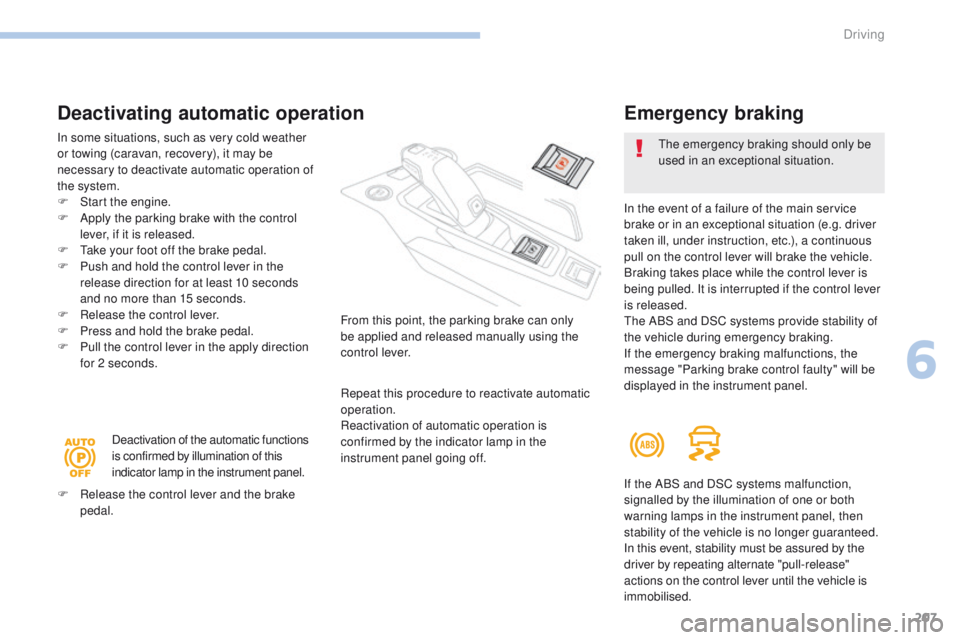
207
3008-2_en_Chap06_conduite_ed01-2016
Deactivating automatic operation
In some situations, such as very cold weather
or towing (caravan, recovery), it may be
necessary to deactivate automatic operation of
the system.
F
S
tart the engine.
F
A
pply the parking brake with the control
lever, if it is released.
F
T
ake your foot off the brake pedal.
F
P
ush and hold the control lever in the
release direction for at least 10 seconds
and no more than 15 seconds.
F
R
elease the control lever.
F
P
ress and hold the brake pedal.
F
P
ull the control lever in the apply direction
for 2 seconds.
Deactivation of the automatic functions
is confirmed by illumination of this
indicator lamp in the instrument panel.
F
R
elease the control lever and the brake
pedal. From this point, the parking brake can only
be applied and released manually using the
control lever.
Repeat this procedure to reactivate automatic
operation.
Reactivation of automatic operation is
confirmed by the indicator lamp in the
instrument panel going off.
Emergency braking
The emergency braking should only be
used in an exceptional situation.
In the event of a failure of the main service
brake or in an exceptional situation (e.g. driver
taken ill, under instruction, etc.), a continuous
pull on the control lever will brake the vehicle.
Braking takes place while the control lever is
being pulled. It is interrupted if the control lever
is released.
The ABS and DSC systems provide stability of
the vehicle during emergency braking.
If the emergency braking malfunctions, the
message "Parking brake control faulty" will be
displayed in the instrument panel.
If the ABS and DSC systems malfunction,
signalled by the illumination of one or both
warning lamps in the instrument panel, then
stability of the vehicle is no longer guaranteed.
In this event, stability must be assured by the
driver by repeating alternate "pull-release"
actions on the control lever until the vehicle is
immobilised.
6
Driving
Page 210 of 566
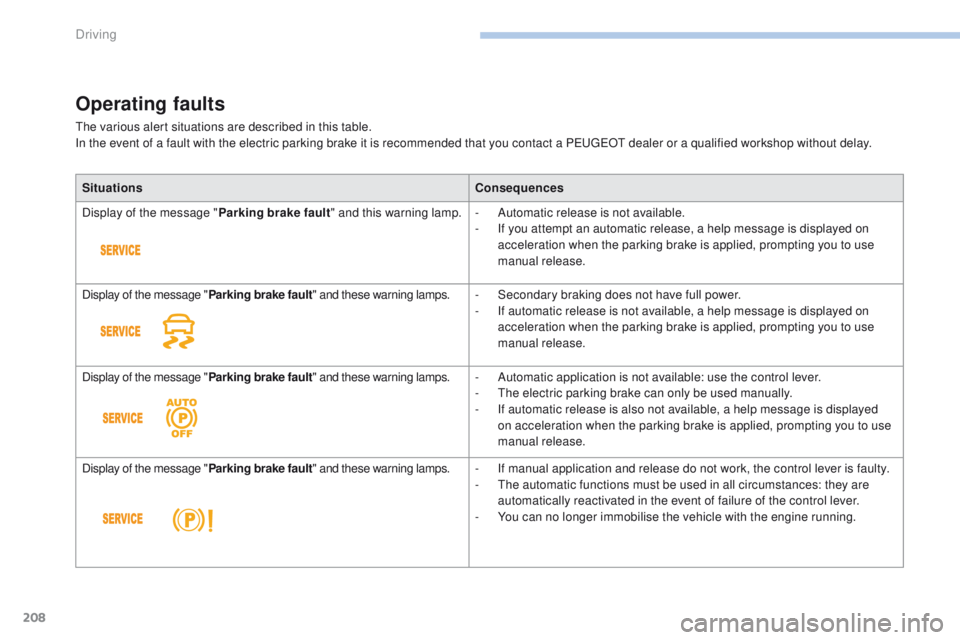
208
3008-2_en_Chap06_conduite_ed01-2016
Operating faults
The various alert situations are described in this table.
In the event of a fault with the electric parking brake it is recommended that you contact a PEUGEOT dealer or a qualified workshop without delay.Situations Consequences
Display of the message " Parking brake fault" and this warning lamp. -
A
utomatic release is not available.
-
I
f you attempt an automatic release, a help message is displayed on
acceleration when the parking brake is applied, prompting you to use
manual release.
Display of the message " Parking brake fault" and these warning lamps. -
S
econdary braking does not have full power.
-
I
f automatic release is not available, a help message is displayed on
acceleration when the parking brake is applied, prompting you to use
manual release.
Display of the message " Parking brake fault" and these warning lamps. -
A
utomatic application is not available: use the control lever.
-
T
he electric parking brake can only be used manually.
-
I
f automatic release is also not available, a help message is displayed
on acceleration when the parking brake is applied, prompting you to use
manual release.
Display of the message " Parking brake fault" and these warning lamps. -
I
f manual application and release do not work, the control lever is faulty.
-
T
he automatic functions must be used in all circumstances: they are
automatically reactivated in the event of failure of the control lever.
-
Y
ou can no longer immobilise the vehicle with the engine running.
Driving
Page 211 of 566
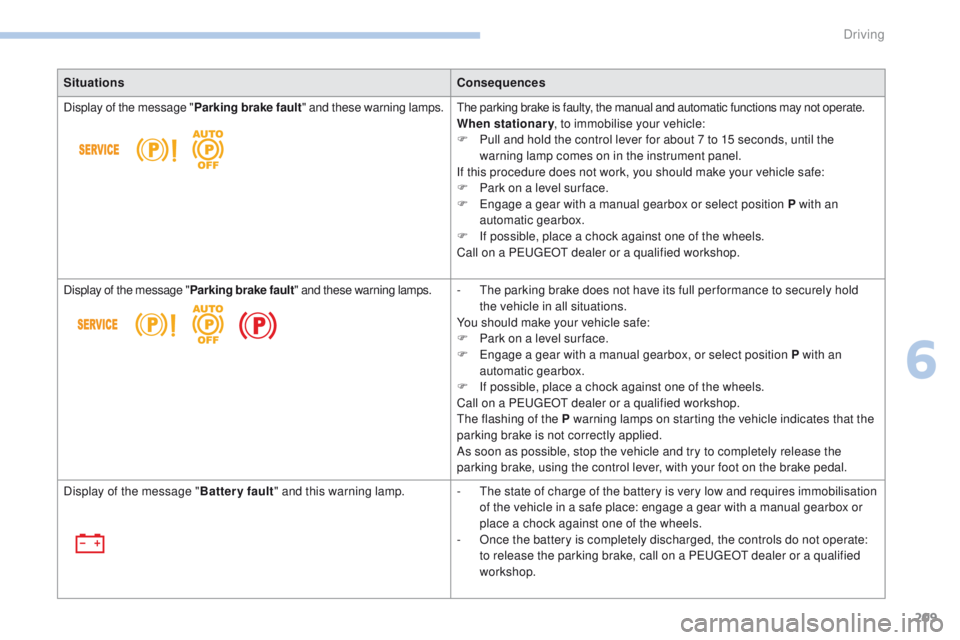
209
3008-2_en_Chap06_conduite_ed01-2016
SituationsConsequences
Display of the message " Parking brake fault" and these warning lamps. The parking brake is faulty, the manual and automatic functions may not operate.
When stationary, to immobilise your vehicle:
F
P
ull and hold the control lever for about 7 to 15 seconds, until the
warning lamp comes on in the instrument panel.
If this procedure does not work, you should make your vehicle safe:
F
P
ark on a level sur face.
F
E
ngage a gear with a manual gearbox or select position P with an
automatic gearbox.
F
I
f possible, place a chock against one of the wheels.
Call on a PEUGEOT dealer or a qualified workshop.
Display of the message " Parking brake fault" and these warning lamps. -
T
he parking brake does not have its full per formance to securely hold
the vehicle in all situations.
You should make your vehicle safe:
F
P
ark on a level sur face.
F
E
ngage a gear with a manual gearbox, or select position P with an
automatic gearbox.
F
I
f possible, place a chock against one of the wheels.
Call on a PEUGEOT dealer or a qualified workshop.
The flashing of the P warning lamps on starting the vehicle indicates that the
parking brake is not correctly applied.
As soon as possible, stop the vehicle and try to completely release the
parking brake, using the control lever, with your foot on the brake pedal.
Display of the message " Battery fault" and this warning lamp. -
T
he state of charge of the battery is very low and requires immobilisation
of the vehicle in a safe place: engage a gear with a manual gearbox or
place a chock against one of the wheels.
-
O
nce the battery is completely discharged, the controls do not operate:
to release the parking brake, call on a PEUGEOT dealer or a qualified
workshop.
6
Driving
Page 215 of 566
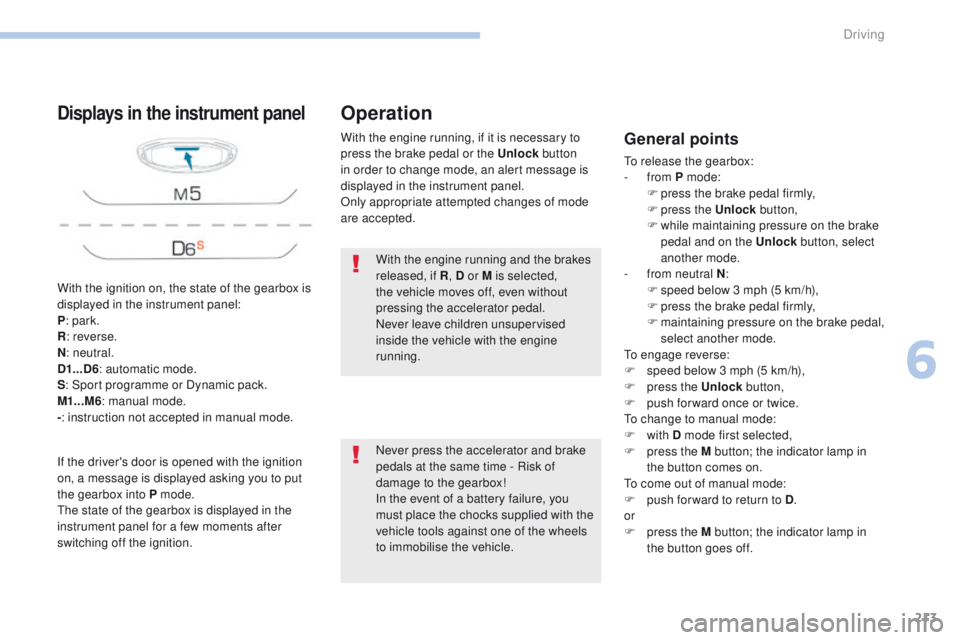
213
3008-2_en_Chap06_conduite_ed01-2016
With the ignition on, the state of the gearbox is
displayed in the instrument panel:
P: park.
R : reverse.
N : neutral.
D1...D6 : automatic mode.
S : Sport programme or Dynamic pack.
M1...M6 : manual mode.
- : instruction not accepted in manual mode.
Displays in the instrument panel
If the driver's door is opened with the ignition
on, a message is displayed asking you to put
the gearbox into P mode.
The state of the gearbox is displayed in the
instrument panel for a few moments after
switching off the ignition. With the engine running, if it is necessary to
press the brake pedal or the Unlock
button
in order to change mode, an alert message is
displayed in the instrument panel.
Only appropriate attempted changes of mode
are accepted.
Operation
General points
To release the gearbox:
- from P mode:
F
p
ress the brake pedal firmly,
F
press the Unlock button,
F
w
hile maintaining pressure on the brake
pedal and on the Unlock button, select
another mode.
-
f
rom neutral N :
F
s
peed below 3 mph (5 km/h),
F
p
ress the brake pedal firmly,
F
m
aintaining pressure on the brake pedal,
select another mode.
To engage reverse:
F
s
peed below 3 mph (5 km/h),
F
p
ress the Unlock button,
F
p
ush forward once or twice.
To change to manual mode:
F
with D mode first selected,
F
p
ress the M button; the indicator lamp in
the button comes on.
To come out of manual mode:
F
p
ush for ward to return to D .
or
F
p
ress the M button; the indicator lamp in
the button goes off.
With the engine running and the brakes
released, if R
, D or M is selected,
the vehicle moves off, even without
pressing the accelerator pedal.
Never leave children unsupervised
inside the vehicle with the engine
running.
Never press the accelerator and brake
pedals at the same time - Risk of
damage to the gearbox!
In the event of a battery failure, you
must place the chocks supplied with the
vehicle tools against one of the wheels
to immobilise the vehicle.
6
Driving
Page 216 of 566
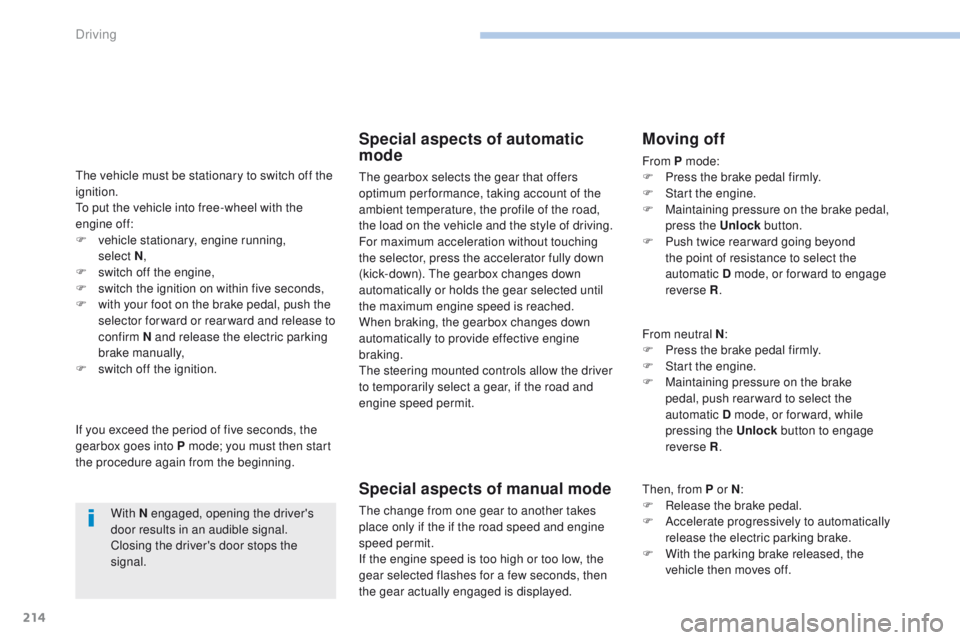
214
3008-2_en_Chap06_conduite_ed01-2016
The vehicle must be stationary to switch off the
ignition.
To put the vehicle into free-wheel with the
engine off:
F
v
ehicle stationary, engine running,
select
N,
F
s
witch off the engine,
F
s
witch the ignition on within five seconds,
F
w
ith your foot on the brake pedal, push the
selector for ward or rear ward and release to
confirm N and release the electric parking
brake manually,
F
s
witch off the ignition.
If you exceed the period of five seconds, the
gearbox goes into P mode; you must then start
the procedure again from the beginning.
Special aspects of automatic
mode
The gearbox selects the gear that offers
optimum per formance, taking account of the
ambient temperature, the profile of the road,
the load on the vehicle and the style of driving.
For maximum acceleration without touching
the selector, press the accelerator fully down
(kick-down). The gearbox changes down
automatically or holds the gear selected until
the maximum engine speed is reached.
When braking, the gearbox changes down
automatically to provide effective engine
braking.
The steering mounted controls allow the driver
to temporarily select a gear, if the road and
engine speed permit.
Special aspects of manual mode
The change from one gear to another takes
place only if the if the road speed and engine
speed permit.
If the engine speed is too high or too low, the
gear selected flashes for a few seconds, then
the gear actually engaged is displayed.
With N engaged, opening the driver's
door results in an audible signal.
Closing the driver's door stops the
signal.
Moving off
From P mode:
F
P ress the brake pedal firmly.
F
S
tart the engine.
F
M
aintaining pressure on the brake pedal,
press the Unlock button.
F
P
ush twice rear ward going beyond
the point of resistance to select the
automatic
D mode, or for ward to engage
reverse R .
From neutral N :
F
P
ress the brake pedal firmly.
F
S
tart the engine.
F
M
aintaining pressure on the brake
pedal, push rear ward to select the
automatic
D mode, or for ward, while
pressing the Unlock
button to engage
reverse R .
Then, from P or N :
F
R
elease the brake pedal.
F
A
ccelerate progressively to automatically
release the electric parking brake.
F
W
ith the parking brake released, the
vehicle then moves off.
Driving